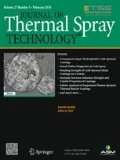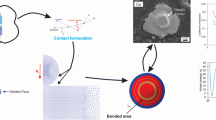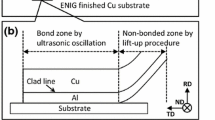Abstract
In this work, finite element simulations were performed to investigate the competition between bonding and rebounding when a Cu particle of 25 μm in diameter impinged Cu substrate. With the help of cohesive zone model, the trend of the minimal average bonding strength to suppress rebounding (MABSSR) was predicted as a function of initial velocity under certain conditions. Result shows, MABSSR has a nonlinear trend versus initial velocity under the conditions considered. If the real trend of MABSSR is similar to that observed, a hypothesis is presented to explain the critical deposition velocity. Finally, defects in the current work are discussed. Analysis shows the defects have no influence on predicting the overall trend of MABSSR in the current work.









Similar content being viewed by others
Abbreviations
- MABSSR:
-
Minimal average bonding strength to suppress rebounding
- D p :
-
Diameter of particle
- σn :
-
Normal stress at one node
- σs :
-
Shear stress at one node
- NFLS :
-
Normal failure stress (input parameter)
- SFLS :
-
Shear failure stress (input parameter)
- δc :
-
Critical failure distance (input parameter in cohesive zone model)
- RBSCDI:
-
Real bonding strength created during the impact
References
A. Papyrin, V. Kosarev, S. Klinkov, A. Alkhimov, and V.M. Fomin, Cold Spray Technology, Elsevier, Amsterdam, 2006
V.K. Champagne, The Cold Spray Materials Deposition Process: Fundamentals and Applications, Woodhead Publishing Limited and CRC Press LLC, Cambridge, 2007
M. Grujicic, C.L. Zhao, C. Tong, W.S. Derosset, and D. Helfritch, Analysis of the Impact Velocity of Powder Particles in the Cold-Gas Dynamic-Spray Process, Mater. Sci. Eng. A, 2004, 368(1-2), p 222-230
T. Schmidt, F. Gartner, H. Assadi, and H. Kreye, Development of a Generalized Parameter Window for Cold Spray Deposition, Acta Mater., 2006, 54(3), p 729-742
J. Wu, H. Fang, S. Yoon, H. Kim, and C. Lee, The Rebound Phenomenon in Kinetic Spraying Deposition, Scripta Mater., 2006, 54(4), p 665-669
M. Grujicic, J.R. Saylor, D.E. Beasley, W.S. DeRosset, and D. Helfritch, Computational Analysis of the Interfacial Bonding Between Feed-Powder Particles and the Substrate in the Cold-Gas Dynamic-Spray Process, Appl. Surf. Sci., 2003, 219(3-4), p 211-227
H. Assadi, F. Gartner, T. Stoltenhoff, and H. Kreye, Bonding Mechanism in Cold Gas Spraying, Acta Mater., 2003, 51(15), p 4379-4394
M. Grujicic, C.L. Zhao, W.S. DeRosset, and D. Helfritch, Adiabatic Shear Instability Based Mechanism for Particles/Substrate Bonding in the Cold-Gas Dynamic-Spray Process, Mater. Des., 2004, 25(8), p 681-688
G. Bae, Y. Xiong, S. Kumar, K. Kang, and C. Lee, General Aspects of Interface Bonding in Kinetic Sprayed Coatings, Acta Mater., 2008, 56(17), p 4858-4868
V.K. Champagne, D. Helfritch, P. Leyman, S.G. Ahl, and B. Klotz, Interface Material Mixing Formed by the Deposition of Copper on Aluminum by Means of the Cold Spray Process, J. Therm. Spray Technol., 2005, 14(3), p 330-334
A. Manap, T. Okabe, and K. Ogawa, Computer Simulation of Cold Sprayed Deposition Using Smoothed Particle Hydrodynamics, Procedia Eng., 2011, 10, p 1145-1150
B. Yildirim, S. Mueftue, and A. Gouldstone, On Cohesion of Micron Scale Metal Particles in High Velocity Impact with a Metal Substrate, Proceedings of the ASME/STLE International Joint Tribology Conference—2011, Oct. 24-26, 2011 (Los Angeles, CA), ASME, 2012, p 373-375
J.O. Hallquist, LS-DYNA Keyword User’s Manual, Livermore Software Technology Corporation, Livermore, CA, 2009
B. Yildirim, S. Muftu, and A. Gouldstone, Modeling of High Velocity Impact of Spherical Particles, Wear, 2011, 270(9-10), p 703-713
M.A. Meyers, Dynamic Behavior of Materials, Wiley-Interscience publication, New York, 1994, p 126-135
G.R. Johnson and W.H. Cook, A Constitutive Model and Data for Metals Subjected to Large Strains, High Strain Rates and High Temperatures, Proceedings of the 7th International Symposium on Ballistics, The Hague, Netherlands: International Ballistics Committee, 1983, p 541-547
P.J. Blau, Friction, Lubrication, and Wear Technology, Chap. 1.2, ASM Handbook, 10th edn, ASM International, Materials Park, 1992
T. Schmidt, “Kaltgasspritzen: Eine Analyse Des Materialverhaltens Beim Partikelaufprall Und Die Daraus Abgeleitete Prozessoptimierung,” Ph.D. Thesis, Helmut Schmidt University, 2007
S. Bala and J. Day, General Guidelines for Crash Analysis in LS-DYNA, http://awg.lstc.com/tiki/tiki-download_file.php?fileId=18, Accessed Aug 19, 2014
Oxygen-Free High Conductivity Copper, Soft, UNS C10200, http://matweb.com/search/DataSheet.aspx?MatGUID=a629b7c5643b44bfb25b9bba7f8140ab, Accessed Sept 30, 2013
J.D. Clayton and J.J. Rencis, Numerical Integration in the Axisymmetric Finite Element Formulation, Adv. Eng. Softw., 2000, 31(2), p 137-141
T. Erhart, Review of Solid Element Formulations in LS-DYNA, Forum 2011—Entwicklerforum, Oct. 12-13, 2011 (Stuttgart, Germany), 2011
S. Bala, Tiebreak Contact in LS-DYNA, 2007, http://blog2.d3view.com/tiebreak-contact-in-ls-dyna/, Accessed June 25, 2014
J.T. Wang, Investigating Some Technical Issues on Cohesive Zone Modeling of Fracture, J. Eng. Mater. Technol., 2013, 135(1), p 011003
M. Elices, G.V. Guinea, J. Gomez, and J. Planas, The Cohesive Zone Model: Advantages, Limitations and Challenges, Eng. Fract. Mech., 2002, 69(2), p 137-163
G.T. Camacho and M. Ortiz, Computational Modelling of Impact Damage in Brittle Materials, Int. J. Solids Struct., 1996, 33(20-22), p 2899-2938
N. Chandra, H. Li, C. Shet, and H. Ghonem, Some Issues in the Application of Cohesive Zone Models for Metal-Ceramic Interfaces, Int. J. Solids Struct., 2002, 39(10), p 2827-2855
S. Yin, X. Wang, W. Li, H. Liao, and H. Jie, Deformation Behavior of the Oxide Film on the Surface of Cold Sprayed Powder Particle, Appl. Surf. Sci., 2012, 259, p 294-300
T. Schmidt, H. Assadi, F. Gaertner, H. Richter, T. Stoltenhoff, H. Kreye, and T. Klassen, From Particle Acceleration to Impact and Bonding in Cold Spraying, J. Therm. Spray Technol., 2009, 18(5-6), p 794-808
S. Bala, Best Practices for Modeling Recoverable Low Density Foams—by Example, 2006, http://blog2.d3view.com/best-practices-for-modeling-recoverable-low-density-foams-by-example/, Accessed June 25, 2014
Y.V. Kurochkin, Y.N. Demin, and S.I. Soldatenkov, Demonstration of the Method of Cold Gasdynamic Spraying of Coatings, Chem. Pet. Eng., 2002, 38(3-4), p 245-248
F.P. Bowden and E.H. Freitag, The Friction of Solids at Very High Speeds. 1. Metal on Metal. 2. Metal on Diamond, Proc. R. Soc. London, Ser. A, 1958, 248(1254), p 350
F.P. Bowden and P.A. Persson, Deformation, Heating and Melting of Solids in High-Speed Friction, Proc. R. Soc. London, Ser. A, 1961, 260(1300), p 433-451
E.A. Avallone, T. Baumeister, and A. Sadegh, Marks’ Standard Handbook for Mechanical Engineers (Standard Handbook for Mechanical Engineers), Chap. 3, 11th edn, McGraw-Hill, New York, 2006, p. 22
F. Gartner, T. Stoltenhoff, C. Borchers, and H. Kreye, Microstructures and Key Properties of Cold-Sprayed and Thermally Sprayed Copper Coatings, Surf. Coat. Technol., 2006, 200(16-17), p 4947-4960
F. Gartner, T. Stoltenhoff, J. Voyer, H. Kreye, S. Riekehr, and M. Kocak, Mechanical Properties of Cold-Sprayed and Thermally Sprayed Copper Coatings, Surf. Coat. Technol., 2006, 200(24), p 6770-6782
Acknowledgments
The authors would like to gratefully thank the Supercomputing Center of Chinese Academy of Sciences for offering computing resources. James Kennedy in LS-DYNA user group on Yahoo is gratefully acknowledged for offering advice about the choice between 3D simulation and 2D axisymmetric simulation as well as between different 3D meshes. The financial support of National Natural Science Foundation of China (No. 50971127) and (No. 50902131) are also gratefully acknowledged.
Author information
Authors and Affiliations
Corresponding author
Additional information
This article is an invited paper selected from presentations at the 2014 International Thermal Spray Conference, held May 21-23, 2014, in Barcelona, Spain, and has been expanded from the original presentation.
Rights and permissions
About this article
Cite this article
Wang, K., Kong, L., Tao, Y. et al. Numerical Simulation of Minimal Average Bonding Strength to Suppress Rebounding in Cold Spraying Cu/Cu: A Preliminary Study. J Therm Spray Tech 24, 75–85 (2015). https://doi.org/10.1007/s11666-014-0150-x
Received:
Revised:
Published:
Issue Date:
DOI: https://doi.org/10.1007/s11666-014-0150-x




